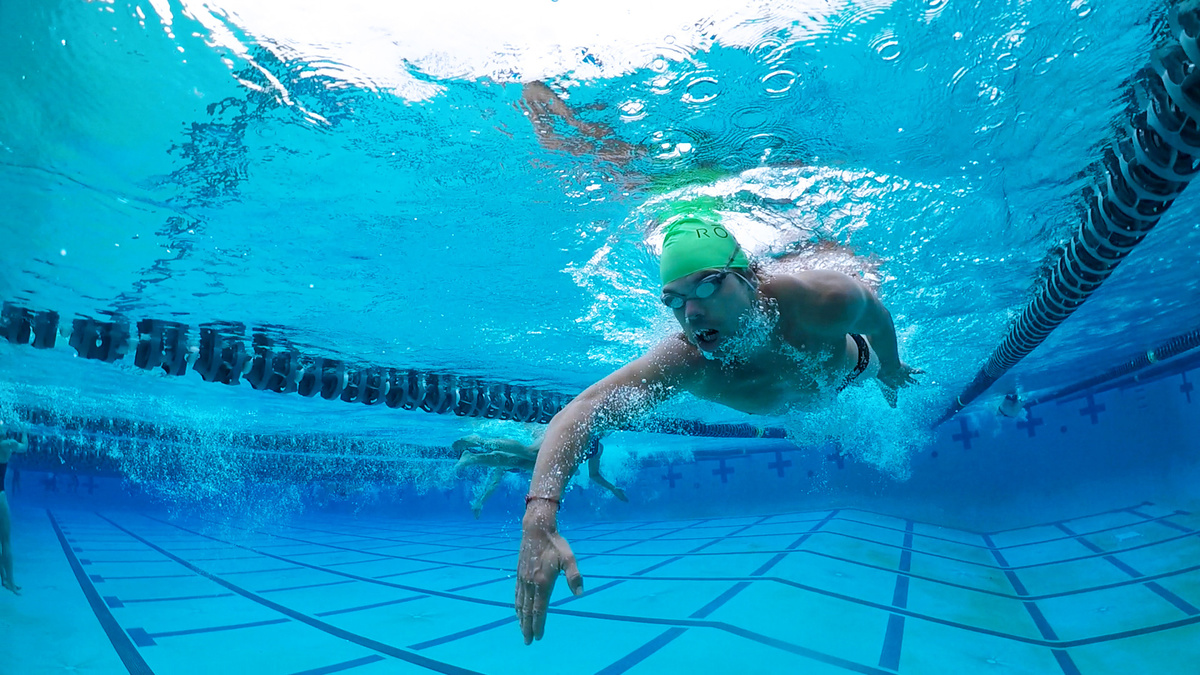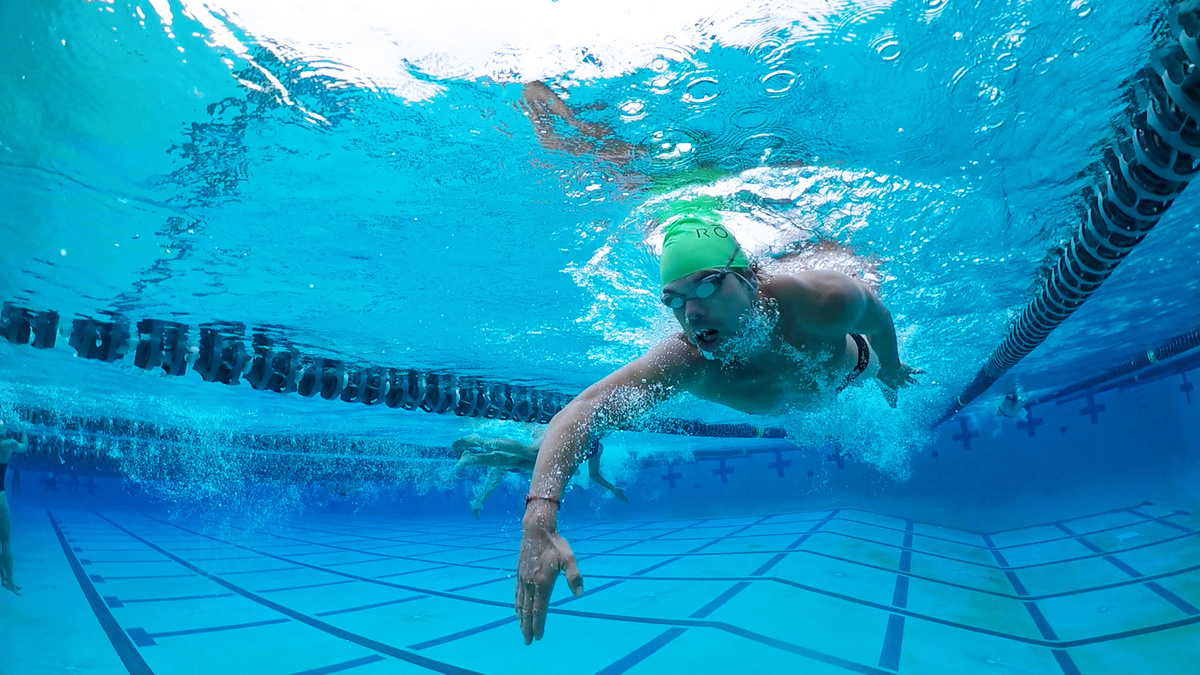
If you’re looking to knock your next triathlon out of the park, then conquering the swim is key! Setting yourself up for your best swim will rely heavily upon your preparation in training. Just like cycling and running, swim training will include many similar pieces: a warm-up, main set, and cool-down. The difference is that swimming uses only distance-based efforts versus time-based efforts. Another key difference with swimming is that rest periods will be static rest, meaning you will be “at the wall,” until the clock hits for the next interval. While there are times when easy recovery swim between sets will occur, during a set, the rest will more than likely be static….and you’ll need it! With so much of the sport requiring you to have your head in the water, you’ll be looking forward to some time to rest and catch your breath!
It is also important to note that swim sets will vary depending on the goal of the session. While a 2-hour bike ride is simply 2 hours, a 3,000 yard/meter swim set may take either 60 minutes or even 90 minutes, etc. The time depends on your swimming speed, as well as the amount of rest taken during intervals and sets.
Practice Structure
While at times swim sets can get a bit overwhelming and confusing to understand, it’s easier to break it down into four different swim training parts:
- Warm Up
- Drills / Optional Activation
- Main Set
- Cool Down
Swim jargon can also be a bit puzzling especially for the first time. Below we will breakdown some colloquial swim terminology to help make better sense of a session:
- When people refer to a 25, 50, 75, 100, etc, they are referring to the distance they swim. Pools are typically either: 25 yards, 25 meters, or 50 meters. A 25 (whether meters of yards) refers to 1 length of the pool, 50 yds/m refers to 2 lengths of the pool. With this continuation, 100 would reference 4 lengths, 200 yards / meters = 8 lengths, and so on. With respect to a 50 meter pool, this is just 2×25 meters placed back to back with no wall in between. One length in a 50 meter pool is equal to 50 meters, and then 2 lengths is 100 meters and so on.
- “Leaving on the top or bottom” – Most pools will have a pace clock on or near the pool deck line of sight. Clocks can either be analog or digital. If someone uses the phrase, “leaving on the top” this means on the :00. When someone says, “leaving on the bottom,” this references the :30 mark.
- In swimming, sets can be written with a send off interval. If you have ever heard someone say, “we did 100s on 1:30,” this means that from the time they pushed off the wall, swam the hundred, then pushed off again, 1:30 went by. If the swimmer left on the :00 for 100 yards/meters, then they would leave on the 1:30 for the next interval.
- If a set is written with a “rest interval” such as 4 x 50 yds/m with :10 rest; this means that once you hit the wall to conclude a 50, you will look at the pace clock to count :10, and then push off the wall again once the :10 has been reached for rest.
Warm-Up
Many swim sessions for triathletes will follow a consistent swim workout routine. The warm-up will be used to get things moving in your body and to transition yourself to be ready to train for harder efforts coming up. The length of the warm-up will vary per the individual, and while not limited to these distances can vary from 200 to 1000 yards/meters. Typically there is not much specificity in the opening laps of a swim practice as they are to help you to loosen up.
Drills
The next piece in a swim session will be incorporating drills and optional activation work. Drills are often one of the most overlooked pieces of a swim set for triathletes, but quite often, the most important. Drills are used to improve your swimming form and technique to help you “hold the water” better and to get a better feel of your stroke. These drill sets are typically shorter efforts ranging in 25s, 50s, or 75s to ensure focus on the task can be maintained with adequate rest and recovery between efforts. Note: Paying conscious attention to how you swim drills is very important, not just “doing” them mindlessly.
Activation
While activation can be optional, it is a great piece to implement especially for sprint sessions or higher VO2 sessions where you will be readily calling upon fast-twitch muscle fibers to activate. These efforts typically include shorter efforts to “prime” your neuromuscular and cardio-metabolic processes to be ready for the main set. Example: 6 x 50 build from moderate to fast through the 50.
Main Set
The main set will be your sessions’ primary efforts. It is important to note that while this is called the “set” (singular), main sets can often be multiple sets of specific repeats or a mix of different distance efforts/intensities. During these sets, longer intervals, shorter intervals, and mixed intervals on different paces and rest are possible.
**Optional Additional Volume/Efforts – Kick/Pull and/or Drills that are performed after the main set are used to reinforce specific technical skills/techniques when fatigued to recenter focus on improving swim skills.
Cool Down
The cool-down consists of easy final 100-300 yards/meters to transition toward recovery.
The above is an example of a standard swim session breakdown, but for multisport athletes, many coaches like to include continuous swims to help develop sustained endurance for open water swimming. If it is possible to complete this in an open water setting to help work on sighting, etc. When you are performing this in a pool, it is good to incorporate sighting drills every few laps to help strengthen the muscles required to effectively lift your head out of the water and tilt for sight when open water swimming. These continuous swims can be anywhere from 20-40 minutes in duration.
Tips:
Try playing around with your stroke rate when you’re practicing. Developing strong powerful strokes are a key piece of success in swimming, both open water and in a pool. Practicing low stroke rate drills can help develop good coordination between your arms, core, and legs. While in cycling and running we may use the term cadence, in swimming it is referred to as strokes per length. For example, count how many arm strokes it takes you to swim from one end of the pool to the other. Next time you do a continuous swim see if you can keep track of each lap of your stroke count. Can you decrease your strokes per length? Can you increase them? Be sure to incorporate a good kick!
Try to couple stroke rate with breathing frequency (how many strokes/breath). It is important to incorporate off-side breathing and alternate breathing in training to ensure that you are prepared to breathe on either side effectively based on a given course that might have sun or waves that require you to breathe to one side or the other. Also, alternate breathing tends to help athletes swim straighter in open water. Stroke rate in open water varies based on the water conditions – where when it’s smooth conditions a longer distance per stroke/slower stroke rate is effective…and when it’s choppy a quicker stroke rate is more effective. These reasons help strengthen the importance of practicing both high and low stroke rate during sessions!


